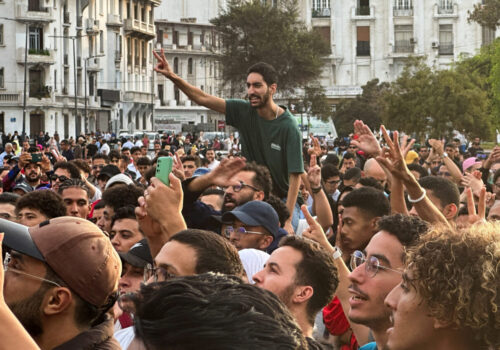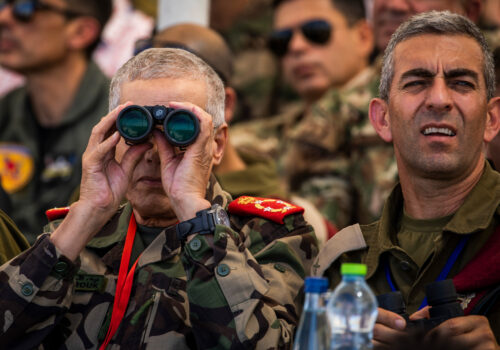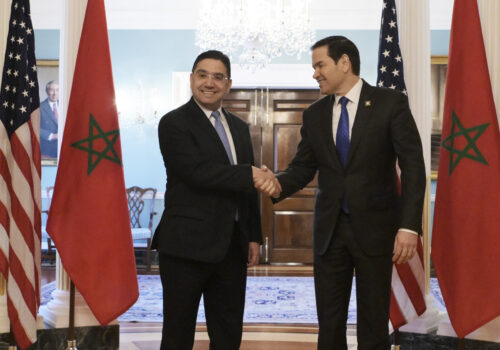‘Bread and circuses’ no more: Morocco’s Gen Z rejects spectacle politics
The term “bread and circuses,” first used by Roman poet Juvenal to criticize the emperors’ appeasement of the masses through basic needs and grandiose gladiator shows, echoes today in many of Morocco’s disjointed development plans. This perception by the country’s youth that Rabat actively governs its citizens with “bread and circuses” is at the center of a wave of demonstrations that have shaken Morocco since September 27.
The younger “Gen Z” generation is leading the latest protest movement, demanding greater government accountability and structural reforms in the fields of employment, health, and education. The movement represents the largest mass protest the country has seen since the February 20, 2011, Arab Spring uprisings. These demonstrations place Morocco at a crossroads between spectacle and substance, as its youth are no longer content with “bread and circuses” alone. The most anticipated reaction, however, is due this week—with a consequential address from King Mohamed VI to the parliament set for October 10.
A healthy sign in a two-speed country
On September 11, Morocco celebrated the inauguration of its state-of-the-art Prince Moulay Abdellah soccer stadium in Rabat, which has a capacity of 68,500 and a construction cost of over $75 million. This architectural jewel was completed in under two years, just months before hosting the 2025 African Cup of Nations. Three days later, protests erupted in the coastal city of Agadir over medical negligence, leading to the alleged death of several female patients. The incident, along with the stark contrast between the country’s sports ambitions and public health policies, fueled public outrage among Morocco’s youth online, leading to the launch of the #GenZ212 hashtag and calls for protests.
The kingdom lives in a disjointed reality, where the government prioritizes large-scale infrastructure and entertainment projects over the country’s external branding and tourism industry at the expense of investing in servicing its citizens. This reality was best described with the words of the kingdom’s own monarch: “a two-speed country.”
Morocco, for example, is eleventh in the world on the FIFA soccer ranking, yet ranks 120th out of 193 countries in the United Nations’ 2025 Human Development Index (HDI). It is building the largest stadium in the world in anticipation of hosting the 2030 World Cup, yet it still sits in the bottom half globally of the Healthcare Index score. It rose to second place as the fastest bullet train in the world and dropped to ninety-eighth place in the Global Knowledge Index.
Protests in a stable and dynamic country like Morocco, with a historical empire muscle and a proven survival record over the past twelve centuries, should be seen as a positive form of political participation. That’s especially true given the outsized participation of a younger, statistically more apathetic generation—and serves as a sign of a healthy society holding accountable its elected officials amid the apparent failure of performative, spectacle politics. Nonetheless, danger persists if the demonstrations spiral further. The protests have already seen moments of confrontation and vandalism, resulting in casualties, signaling how volatile the situation could become.
A generation searching for the ‘One Piece’
To understand the ongoing demonstrations, it’s essential to understand the generation that drives them. There are nearly eleven million Moroccans between the ages of fifteen and thirty-four, a quarter of whom are NEET (Not in Education, Employment, or Training), according to a recent study by the Moroccan Economic, Social, and Environmental Council (CESE). The rates are far worse among women and in rural populations. Morocco’s unemployment rate soared to 13.3 percent in 2024, as the economy continues to recover from the COVID-19 crisis, despite achieving significant strides in niche industrial sectors like automotive, aeronautics, and pharmaceuticals. The current Akhannouch government coalition, led by a mishmash of oligarchs and technocrats, vowed to reduce unemployment to under 9 percent and create 350,000 new jobs by 2026, but failed to convince Moroccan youth who grew disenchanted with most political elites.
The numbers place Gen Z as the lowest age group in terms of political participation, with only 33.5 percent of the eighteen to twenty-four-year-olds registered to vote, and 55 percent of the eighteen to twenty-nine age group wanting to emigrate. Still, the massive numbers of youths who took to the streets, paired with their active online engagement, offer a different point of insight on youth political investment. Mobilization content produced on social media platforms like Discord and Instagram demonstrates a sophisticated understanding of political dynamics and a high sense of social justice.
The symbolism used in some social content borrows metaphors from popular culture, such as the Korean series Squid Game or the Spanish drama The Platform—both startling allegories about social injustice and proletarian struggle—confirms the values and aspirations guiding the protests. Similar to Gen Z movements in Nepal, Indonesia, and Europe, there is one Japanese anime that became the main symbol of these protests: One Piece. Moroccan youth seem to identify most with the manga, which tells the story of a brave subaltern youth seeking to defeat the establishment and find a mysterious treasure called the One Piece.
The ‘Zlayji’ versus the ‘Hargaoui’
Gen Z in Morocco, however, is not a homogeneous group, as it comprises several distinct archetypes within the same generation. The Z word, for example, can also apply to the “Zlayji” group of youth. The pejorative term entered the Urban Dictionary in recent years amid the raging cultural war between Morocco and Algeria over heritage symbols, such as the Kaftan, couscous, and Zellij tiles—hence the appellation of Zlayji (tile artisan). A typical Zlayji Gen Z is a fervent defender of Moroccan exceptionalism. He or she unquestioningly supports a supremacist narrative calling for the revival of the glory of the Moorish Empire in North Africa under Moroccan leadership.
The trend, which began as a spontaneous reaction to the ongoing Moroccan-Algerian rivalry, quickly evolved into an ideological tool to further expand the government’s “bread and circuses” posture and disseminate a form of banal nationalism. During the recent events, this group went completely silent, especially the army of online influencers who benefited financially from promoting Morocco’s World Cup ambitions. Others tried to recalibrate and join the new wave, siding with the more peaceful form of demonstrations.
SIGN UP FOR THIS WEEK IN THE MIDEAST NEWSLETTER
In opposition to this class of neo-chauvinists, another archetype appeared in the kingdom’s public sphere: the “Hargaoui.” The term historically refers to a class of “uncivilized” people who behave against the social norms of politeness and respect for public property and order. The appellation Hargaoui, however, is not exclusive to a particular socio-economic class in Moroccan society, but rather a behavioral profile inherited from the era of “Blad Siba”, which was widespread in non-state-governed areas prior to the colonial encounter with the French and Spanish in 1912.
The Hargaoui Gen Z never felt ownership of the infrastructure erected in preparation for the African and World Cups, and even actively engaged in vandalizing stadiums, signaling that they do not adhere to the government’s entertainment-focused development model. This group soon took center stage in what started as peaceful demonstrations, dragging the movement into violent confrontations, leading to the destruction and looting of private and public property.
Where we go from here
Initial government reactions show positive signs of containment and readiness to engage in constructive dialogue and reforms. Some even publicly confessed their failure in governing and responding to the aspirations of the new generations. After the demonstrations turned sour, many opposition leaders, such as Abdelilah Benkirane (the former prime minister from 2011 to 2017), who had initially fueled the discord, started calling for restraint and condemning violence. One year before the next electoral cycle, which is due in September 2026, partisan elites have come to understand the significance of youth in their political future and are attempting to appeal to them. Nevertheless, Gen Z has lost hope in the political class and is demanding accountability and the resignation of the current government.
King Mohamed VI’s address this week will send an important signal on the steps forward. The monarch is largely considered the guarantor of the social contract between elected officials and the citizens and the symbolic “Commander of the Faithful”, according to the Moroccan Constitution. Back in 2011, in the height of the February 20 movement, the king stepped in with bold constitutional reforms and offered a pathway out of the crisis for the country’s Millennial generation. The movement has recently published its petition calling for the King to impeach the government, dissolve certain political parties, and hold public courts to punish fraudulent politicians. These demands pose a real existential conundrum for the very nature of a constitutional monarchy. Such ends will constitute a regression from the gains of the 2011 constitution, limiting the powers of the King in favor of stronger legislative and executive branches, which other generations sacrificed to attain.
An equally crucial response is expected from Crown Prince Moulay El-Hassan, who is actively being groomed for throne succession and is a Gen Z himself. Moulay El-Hassan has been increasingly active in representing his father at important development initiatives, greeting world leaders, and slowly forging a separate, more youthful, and firm public persona for himself. Several protesters have addressed him directly in some of their social media posts and solicited his mediation.
Beneath the spectacle of gleaming stadiums and bullet trains lies a deeper hunger for dignity, accountability, and equity. Just like the pirates of “One Piece”, Gen Z Moroccans are charting their own course toward justice and belonging. Their quest is not against the crown or the system, but against the illusion that performance equals progress. Whether the Makhzen (the establishment) chooses to listen—or continues dazzling itself with its own reflection—will define the trajectory of an entire nation.
Sarah Zaaimi is a resident senior fellow for North Africa at the Atlantic Council’s Middle East Programs, where she also serves as the center’s deputy director for communications.
Further reading
Thu, Oct 2, 2025
Four questions (and expert answers) about the antigovernment protests in Morocco
New Atlanticist By Sarah Zaaimi
Mass protests over economic conditions led by members of Morocco’s Gen Z continued to escalate in multiple cities on Thursday.
Tue, Jan 21, 2025
How the Gaza war brought Morocco and Israel closer
MENASource By Sarah Zaaimi
Security cooperation between Israel and Morocco is flourishing and has never been stronger, driven by a common Iranian threat and a shared vision for regional integration.
Tue, May 6, 2025
A blueprint for a trilateral Morocco-Israel-US investment fund
MENASource By
Amid instability in the Mediterranean, North Africa and the Sahel, a chance to deliver on the promise of the Abraham Accords.
Image: Protesters demonstrate in downtown Casablanca during youth-led demonstrations demanding better education and healthcare, in Casablanca, Morocco, October 3, 2025. REUTERS/Stringer



